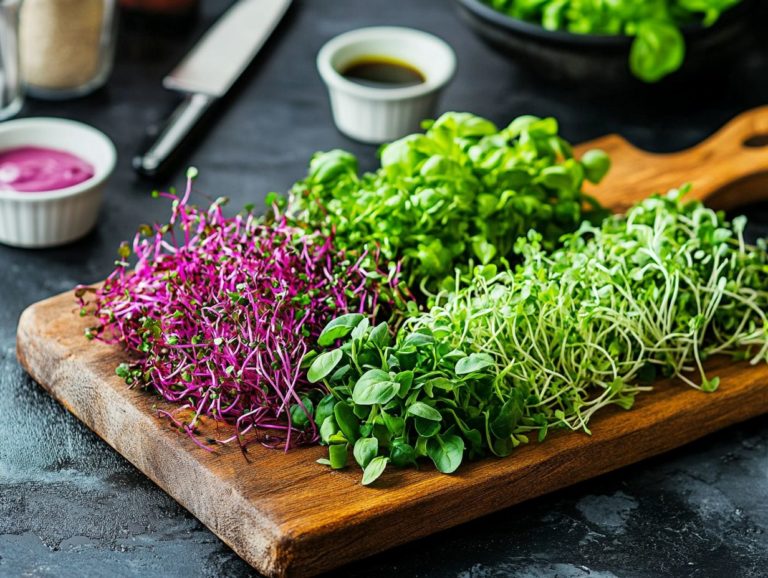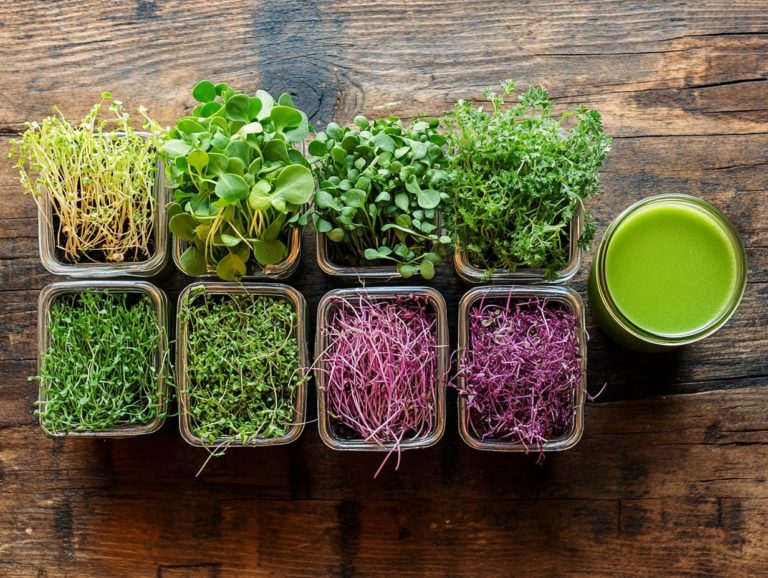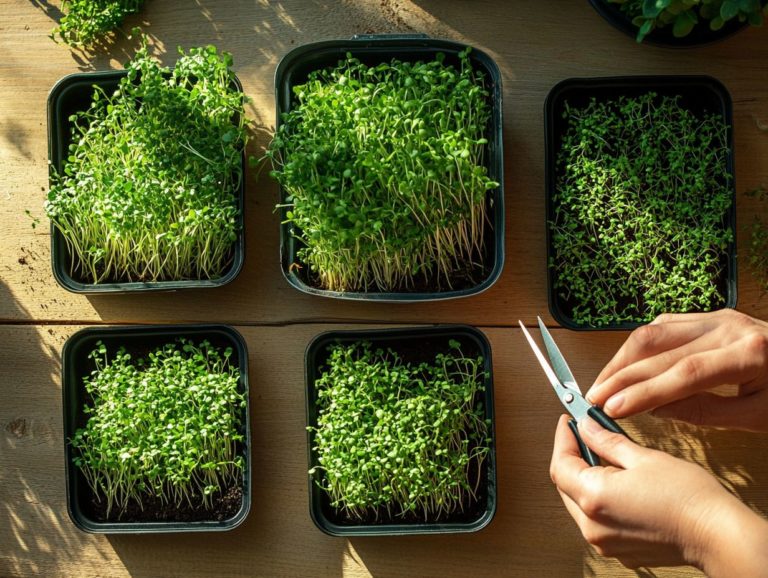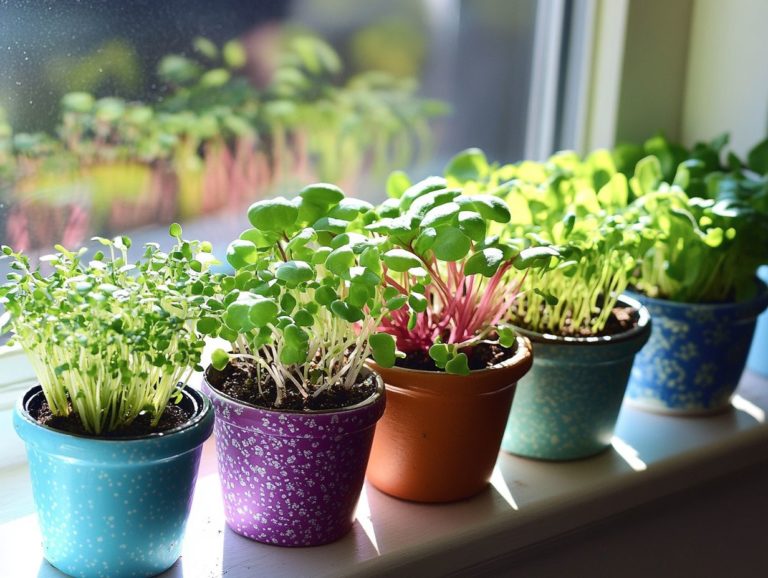Microgreen Varieties: Taste and Flavor Guide
Microgreens are more than just a trendy garnish. They bring a delightful explosion of flavor and a wealth of nutrition in each delicate leaf.
This guide invites you to explore the diverse realm of microgreens, delving into their distinct taste profiles and the factors that shape their flavor.
From popular varieties to practical cooking tips, along with insights on how to grow and store them for peak freshness, you ll discover everything you need to elevate your culinary creations.
Whether you re a seasoned chef or a passionate home cook, the vibrant world of microgreens is ready to inspire you!
Contents
Key Takeaways:
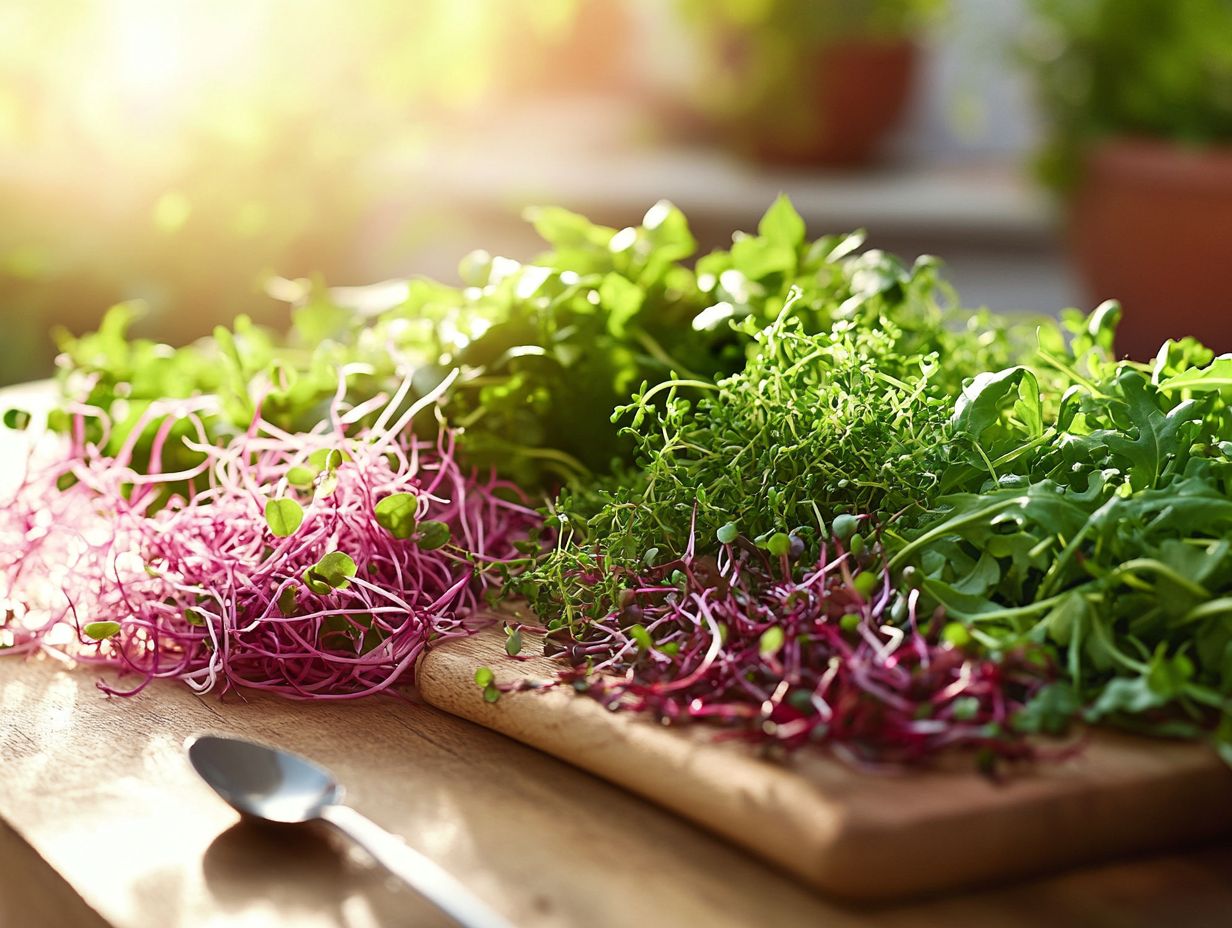
Microgreens offer a burst of flavor in a small package. They enhance dishes with unique tastes.
Growing techniques and harvesting methods greatly impact microgreens’ taste.
Enjoy microgreens fresh as a garnish or add them at the end of cooking for maximum flavor.
What are Microgreens?
Microgreens are young, edible plants that you can harvest shortly after their first true leaves emerge. They re renowned for their intense flavors and vibrant colors. These tiny greens, often sprouted from seeds like mustard, pea, beet, radish, and garden cress, carry a remarkable nutrient profile.
Microgreens offer significant health benefits. They are high in antioxidants and essential vitamins like A, C, and E. With their ease of cultivation, they have become a favorite in both growing food in cities and home gardening, allowing you to enjoy flavorful microgreens within just a few weeks of planting.
Ideal for a variety of cooking uses, microgreens aren’t merely garnishes. They can elevate your salads, sandwiches, and smoothies with their bold tastes and striking aesthetics. To maximize their potential, understanding the growth patterns of microgreen varieties is essential. These amazing little plants thrive in even the smallest spaces and can flourish both indoors and outdoors, as long as they receive sufficient light and moisture.
Since they are harvested at such an early stage, microgreens retain concentrated flavors and a wealth of nutrients beneficial for your health. This makes them a go-to choice for chefs and health enthusiasts alike. With a diverse range of profiles from peppery to sweet, exploring must-try microgreen varieties for salads makes it easy to find the perfect microgreen to enhance any dish you create.
Taste and Flavor of Microgreens
The taste and flavor of microgreens can truly vary, offering a delightful enhancement to a range of dishes and culinary creations. With their concentrated nutrients and vibrant flavors, these tiny greens do more than just serve as a garnish; they play a vital role in elevating the entire taste profile of salads, sandwiches, and other gourmet preparations.
Embrace their versatility and let them transform your meals into extraordinary culinary experiences.
Factors Affecting Taste and Flavor
Several factors influence the taste and flavor of microgreens, including the variety, growing conditions, and harvesting time. You’ll find that environmental elements such as light, water, and soil quality play a crucial role, while the nutrient content of the microgreens themselves enhances their rich flavors and health benefits.
For example, the intensity and duration of light exposure can significantly impact the growth rate and flavor profile of these young plants. When you provide adequate light, it leads to robust chlorophyll production, intensifying their vibrant green hue and contributing to a more nuanced taste.
The type of soil you choose whether it s a rich, organic mix or a simple peat base also supplies essential nutrients that nourish the microgreens. Watering strategies, including frequency and method, are vital as well; overwatering can dilute flavors, while insufficient moisture can stunt growth and diminish taste.
By understanding these factors, you’ll be equipped to cultivate microgreens that are not only bursting with flavor but also packed with nutrition.
Popular Microgreen Varieties
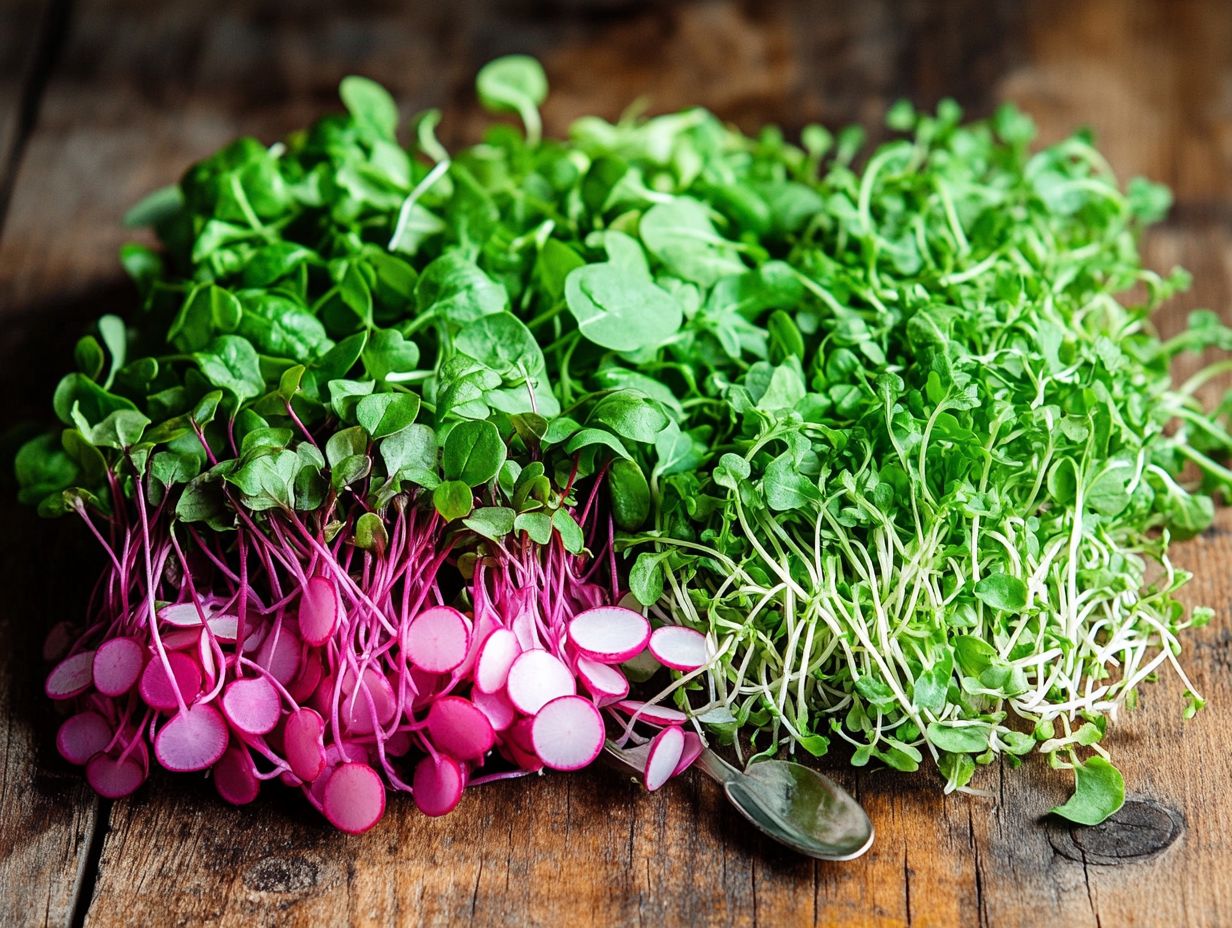
Among the countless varieties of microgreens, some have risen to prominence as favorites among both chefs and home cooks. Their unique flavors and rapid harvest times set them apart.
Mustard, pea, beet, radish, and garden cress microgreens stand out, boasting vibrant colors and distinctive tastes. With their rich nutrient profiles, these microgreens have become essential in the culinary world, enhancing dishes with both visual appeal and exceptional flavor.
Taste and Flavor Profiles of Different Varieties
Microgreens add unique tastes to your meals. Mustard microgreens offer a peppery kick, while pea microgreens bring a sweet, fresh flavor.
Beet microgreens add earthy notes, and radish microgreens contribute a zesty crunch that’s bursting with flavor.
The delicate taste of arugula microgreens offers a nutty, slightly bitter undertone, making them an excellent choice for salads or as a garnish on pizzas. For a broader selection, check out this quick guide to common microgreen varieties. Sunflower microgreens, celebrated for their mild, nutty flavor, can be seamlessly blended into smoothies or used as vibrant, crunchy toppings.
Cilantro microgreens are another fantastic option, lending a fresh, citrusy essence that enhances salsas and Asian dishes beautifully. Incorporating these versatile microgreens into your recipes can elevate both the visual appeal and taste of your dishes, adding an innovative twist to your everyday meals. To explore more, check out microgreen varieties: what you need to know.
How to Use Microgreens in Cooking
Incorporating microgreens into your cooking can truly elevate your dishes with their vibrant flavors and impressive health benefits, turning them into a must-have in your kitchen.
Whether you re garnishing soups and salads, blending them into smoothies, or using them as a foundation for your delicious dishes, the possibilities with these greens packed with vitamins and minerals are virtually limitless.
Tips for Incorporating Microgreens into Dishes
Use microgreens as a garnish to instantly elevate your meals. They boost visual appeal and pack a concentrated nutrient punch.
To take your flavors to the next level, explore combinations that highlight both the microgreens and the main ingredients. For example, pairing peppery arugula microgreens with roasted beets creates a delightful balance of earthiness and spice.
Don’t hesitate to experiment with various plating techniques. Layer them atop a vibrant salad or sprinkle them over soups just before serving for that fresh, eye-catching touch. For those looking to enhance their meals, understanding the role of microgreen varieties in plant-based diets can be beneficial. Timing is key when adding microgreens; tossing them in at the end of preparation maximizes their flavor while keeping them vibrant.
Ultimately, by playfully combining these tiny greens with complementary ingredients, you can transform any dish into a delightful, nutrient-rich experience. For a deeper understanding, refer to the nutrient comparison of popular microgreen varieties that leaves a lasting impression.
Grow Your Own Microgreens Easily!
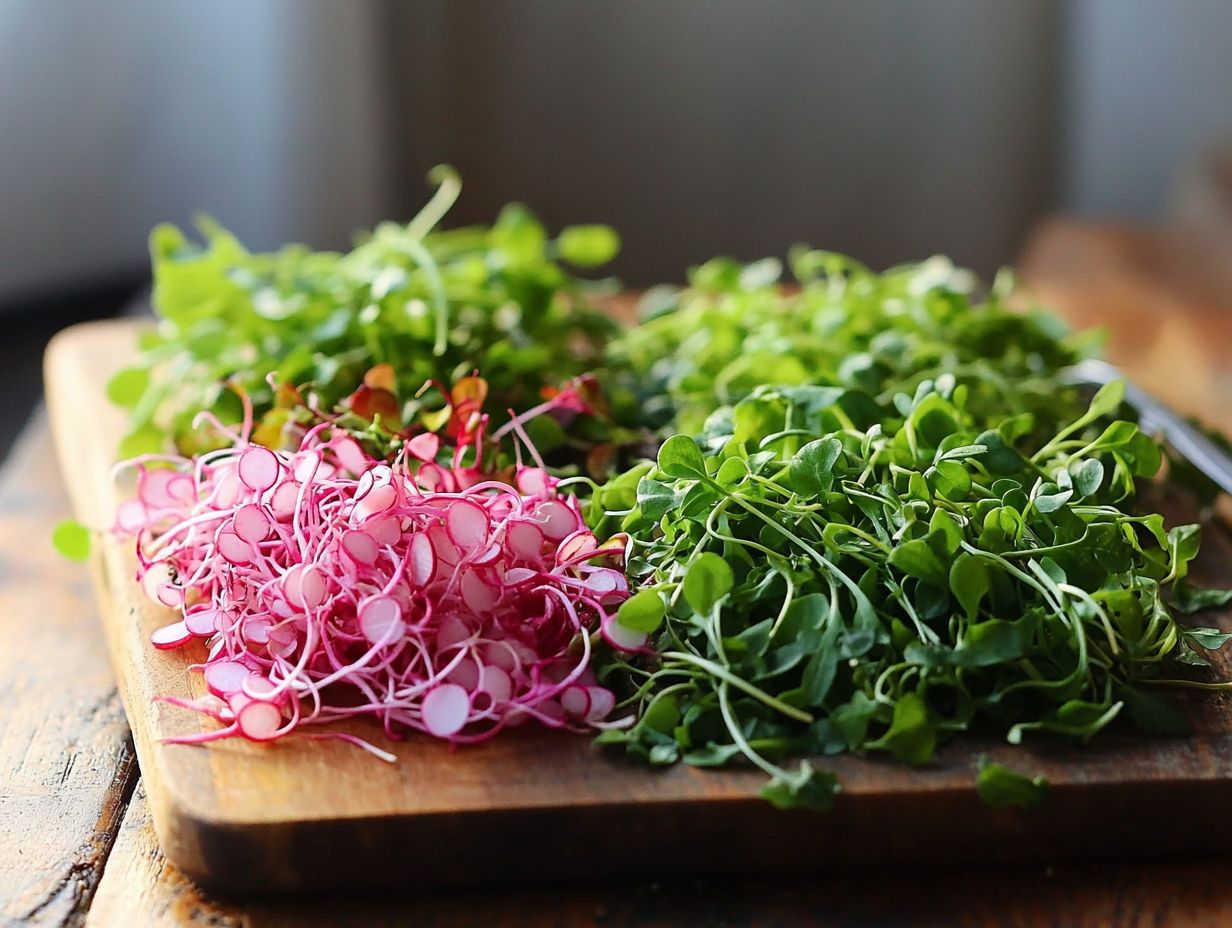
Growing and harvesting microgreens is a remarkably straightforward and fulfilling endeavor, perfect whether you’re just starting out or you’ve been tending to gardens for years.
These nutrient-packed greens thrive beautifully in seed trays indoors, taking up minimal space and requiring little effort. You’ll be delighted to know that you can enjoy a quick harvest just a few weeks after planting, reaping the rewards of your green thumb in no time.
Start growing your microgreens today and taste the difference!
Techniques for Optimal Flavor
To unlock the best flavor from your microgreens, it s vital to employ specific growing techniques. Considerations like light exposure, soil quality, and proper watering are key in cultivating microgreens that are not only delicious but also packed with concentrated nutrients and health benefits.
Utilizing adequate light sources, whether natural or artificial, can significantly elevate the taste profile of your microgreens. A combination of full-spectrum LED lights and natural sunlight promotes robust growth, allowing those greens to develop their unique flavors. To enhance your microgreen experience, consider exploring the best microgreen varieties for sprouting.
Opting for high-quality, nutrient-rich soil can transform your growing experience; organic blends typically create the perfect environment for microgreens to flourish. Regularly monitoring moisture levels through soaking or spraying lightly with water ensures these delicate plants receive consistent hydration.
By honing in on these essential growing practices, you can truly enhance the taste and nutritional quality of your microgreen harvest.
Storing and Preserving Microgreens
Want to keep your microgreens fresh and tasty? Here s how! Properly storing and preserving microgreens is essential for maintaining their freshness, flavor, and health benefits. Use the right techniques to keep these nutrient-rich greens fresh and flavorful.
Best Practices for Maintaining Taste and Flavor
Maintaining the taste and flavor of microgreens requires embracing a few best practices that safeguard their quality. Proper storage, handling, and preparation methods are pivotal in preserving both the flavor and nutrient content of these vibrant greens.
To truly savor their rich taste and health benefits, consider storing microgreens, including mustard microgreens and pea microgreens, in a cool, dark place. A breathable container that allows for air circulation is ideal. When handling these delicate plants, gently wash them and avoid excessive moisture, which can lead to spoilage and negate their health benefits. For the top microgreen varieties for health enthusiasts, incorporating microgreens into your dishes at the last moment enhances their crispness, allowing their unique flavors to shine through.
You can maximize the culinary potential of microgreens by paying attention to these details, effortlessly transforming everyday meals into extraordinary dining experiences.
Frequently Asked Questions
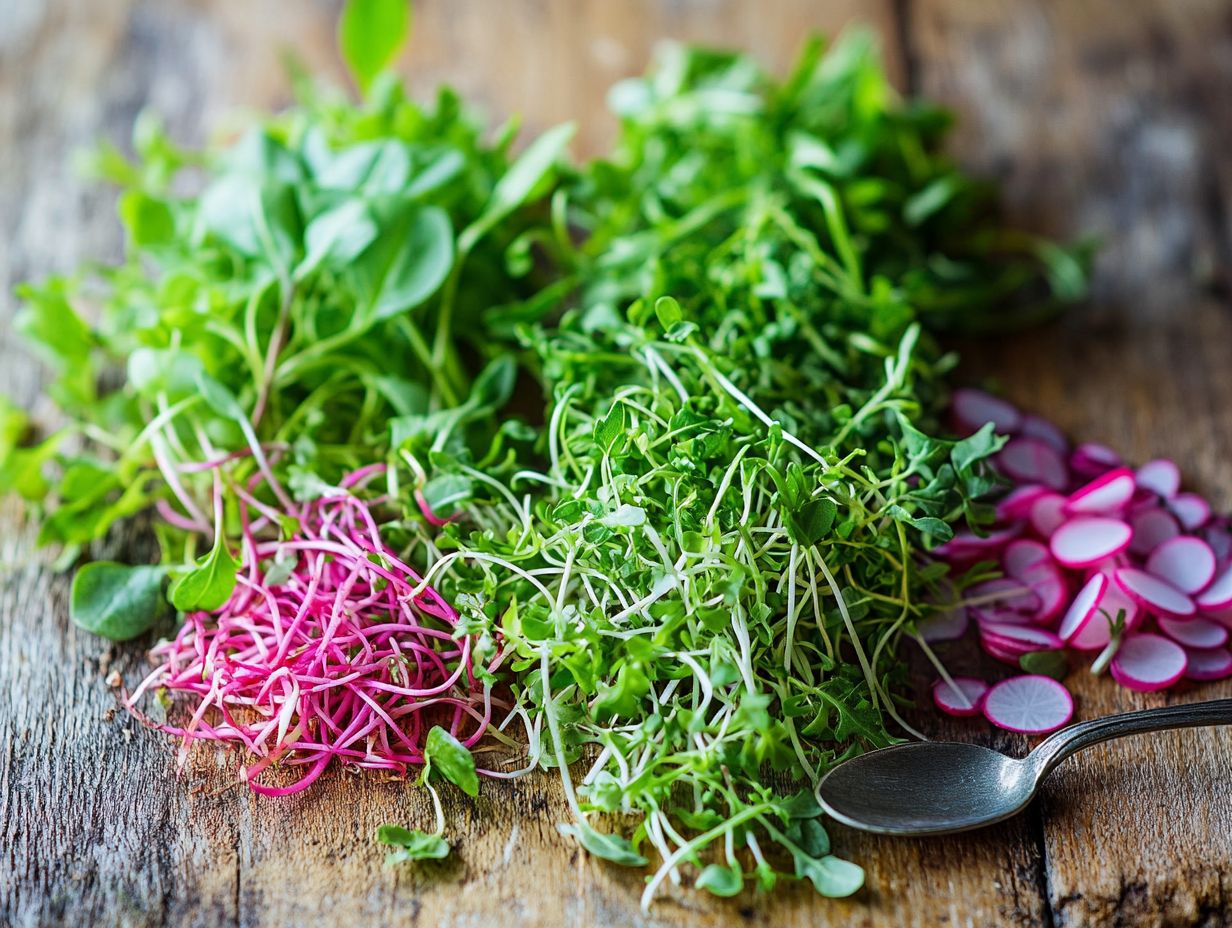
What are microgreens?
Microgreens are young, edible plants that are harvested at the early stage of growth, typically between 7-14 days after germination. They are smaller than baby greens but larger than sprouts and are packed with concentrated nutrients, including vitamins A, C, and E.
How do microgreens differ in taste and flavor?
Microgreens come in a variety of flavors, ranging from sweet and mild to spicy and tangy, like beet microgreens and radish microgreens. Some common flavors include peppery, nutty, earthy, and herbaceous, often found in culinary herbs and popular microgreens. The taste and flavor of microgreens are influenced by a combination of factors, including the type of plant, growing conditions, and harvesting time.
What are the most popular microgreen varieties?
Some of the most popular microgreen varieties include arugula, broccoli, kale, radish, and sunflower. These varieties are a must-try for anyone looking to elevate their cooking!
How do I use microgreens in my cooking?
Microgreens can be used in a variety of ways, such as in salads, sandwiches, soups, and as a garnish for a pop of color and flavor, enhancing Southern cooking traditions. They can also be blended into smoothies or used as a topping for pizza and pasta dishes, providing a quick harvest of flavor-packed nutrients. Experiment with different combinations to find your favorite ways to use microgreens, especially with our beginner’s guide to sprouting seeds.
Are there any microgreen varieties with a mild flavor?
Yes, some microgreen varieties have a mild flavor. Options like lettuce, spinach, and chard are easy to grow and perfect for those who prefer a subtler taste.
They are rich in antioxidants and can be mixed with stronger-flavored microgreens to balance the overall taste.
How can I store microgreens to maintain their freshness?
To keep microgreens fresh, store them in a sealed container or plastic bag in the refrigerator. Using seed trays allows for optimal air circulation.
When stored properly, they can last up to a week. However, using them as soon as possible ensures the best taste and nutrition.

